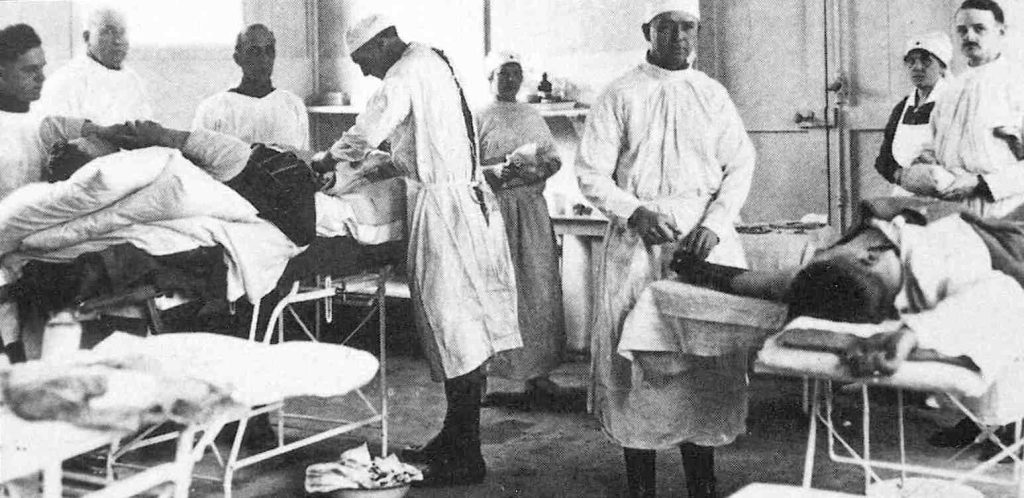Treating Shock
Published (updated: ).

Hypovolemic Shock
In hypovolemic shock, caused by bleeding, it is necessary to immediately control the bleeding (or fluid loss) and restore the patient’s circulating blood volume by giving infusions of isotonic crystalloid solutions (such as Normal Saline or Lactated Ringers). Blood transfusions are necessary for loss of large amounts of blood (e.g. greater than 20% of blood volume), but can be avoided in smaller and slower losses.
Hypovolemia due to burns, diarrhea, vomiting, etc. is treated with infusions of isotonic crystalloids that balance the nature of the fluid lost. Sodium is essential to keep the fluid infused in the extracellular and intravascular space while preventing water intoxication (a condition where the fluids have literally washed away all electrolytes resulting in altered mental status) and brain swelling. Metabolic acidosis (mainly due to lactic acid) accumulates as a result of poor delivery of oxygen to the tissues, and mirrors the severity of the shock. It is best treated by rapidly restoring intravascular volume and perfusion as above. Inotropic and vasoconstrictive drugs should be avoided, as they may interfere in knowing blood volume has returned to normal. Regardless of the cause, the restoration of the circulating volume is priority. As soon as the airway is maintained and oxygen administered the next step is to transport the patient to definitive care and commence replacement of fluids via the intravenous route. Opinion varies on the type of fluid used in shock. The most common are: Crystalloids – Such as sodium chloride (0.9%), or Hartmann’s solution (Ringer’s lactate). Dextrose solutions that contain free water are less effective at re-establishing circulating volume. Colloids – For example, synthetic albumin (Dextran), polygeline (Haemaccel), succunylated gelatin (Gelofusine) and hetastarch (Hepsan). Colloids are, in general, much more expensive than crystalloid solutions and have not conclusively been shown to be of any benefit in the initial treatment of shock (which is why we as EMS personnel typically don’t use Colloid solutions). Combination – Some clinicians argue that individually, colloids and crystalloids can further exacerbate the problem and suggest the combination of crystalloid and colloid solutions. Blood – Essential in severe hemorrhagic shock, often pre-warmed and rapidly infused. Blood may come in the flavor of packed red blood cells, whole blood, or plasma.
Cardiogenic Shock
The main goals of the treatment of cardiogenic shock are the re-establishment of circulation to the myocardium, minimizing heart muscle damage, and improving the heart’s effectiveness as a pump. This is most often performed by percutaneous coronary intervention (angioplasty) and insertion of a stent (small tube inserted into a blood vessel to hold it open) in the culprit coronary lesion or sometimes by cardiac bypass. Although this is a protection reaction, the shock itself will induce problems; the circulatory system being less efficient, the body gets “exhausted,” and finally, the blood circulation and the breathing slow down and finally stop (cardiac arrest). The main way to avoid this deadly consequence is to make the blood pressure rise again with fluid replacement with intravenous infusions (like normal saline and lactated ringers); use of vasopressing drugs (e.g. to induce vasoconstriction, like dopamine);use of blankets to keep the patient warm.
Distributive Shock
In distributive shock caused by sepsis the infection is treated with antibiotics and supportive care is given. Anaphylaxis is treated with epinephrine to stimulate cardiac performance and corticosteroids to reduce the inflammatory response. In neurogenic shock, because of vasodilation in the legs, one of the most suggested treatments is placing the patient in the Trendelenburg position; elevating the legs and shunting blood back from the periphery to the body’s core. However, since blood vessels are highly compliant, and expand as result of the increased volume locally, this technique does not work. More suitable would be the use of vasopressors.
Obstructive Shock
In obstructive shock, the only therapy consists of removing the obstruction. Inserting a chest tube treats pneumothorax or hemothorax. Pulmonary embolism requires thrombolysis (to reduce the size of the clot), or embolectomy (removal of the thrombus). Cardiac tamponade is treated by draining fluid from the pericardial space through pericardiocentesis (in the emergency department). The prognosis of shock depends on the underlying cause and the nature and extent of concurrent problems. Hypovolemic, anaphylactic, and neurogenic shocks are easily treatable and respond well to medical therapy. Septic shock however, is a grave condition and with a mortality rate between 30% and 50%.
Shock is said to evolve from reversible to irreversible in experimental hemorrhagic shock involving certain animal species (dogs, rats, mice) that develop intense vasoconstriction of the gut. Death is due to hemorrhagic necrosis of the intestinal lining when shed blood in reinfused. In pigs and humans this is not seen and cessation of bleeding and restoration of blood volume is usually very effective and prolonged hypovolemia and hypotension does carry a risk of respiratory and then cardiac arrest. Perfusion of the brain may be the greatest danger during shock. Therefore urgent treatment (cessation of bleeding, rapid restoration of circulating blood volume and ready respiratory support) is essential for a good prognosis in hypovolemic shock.
